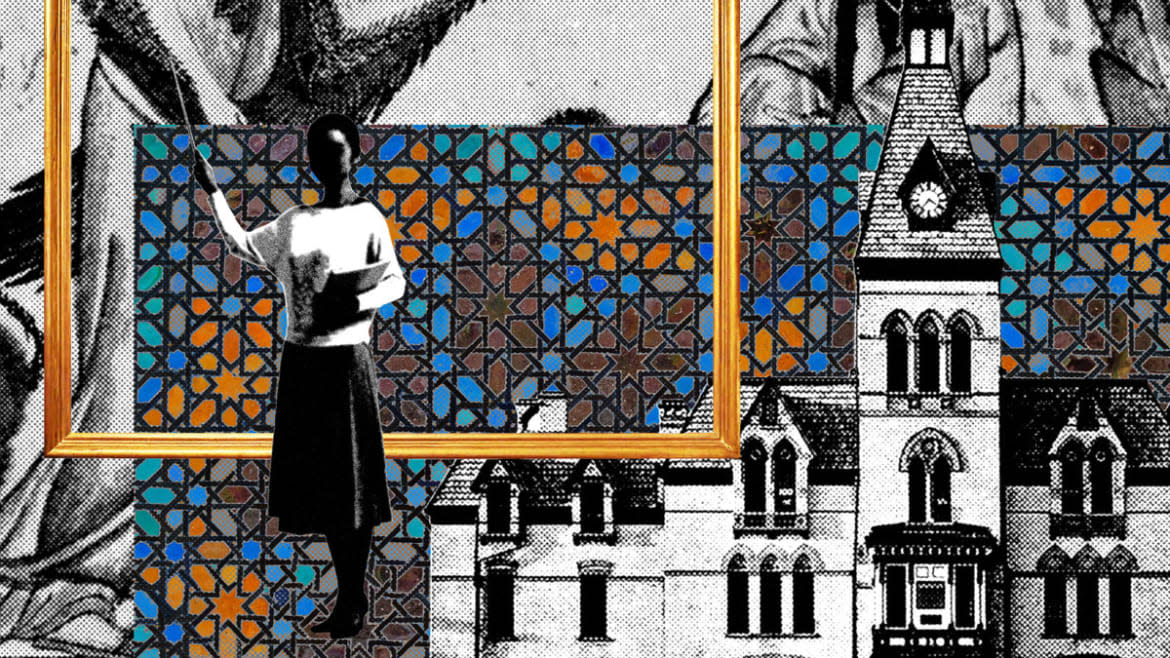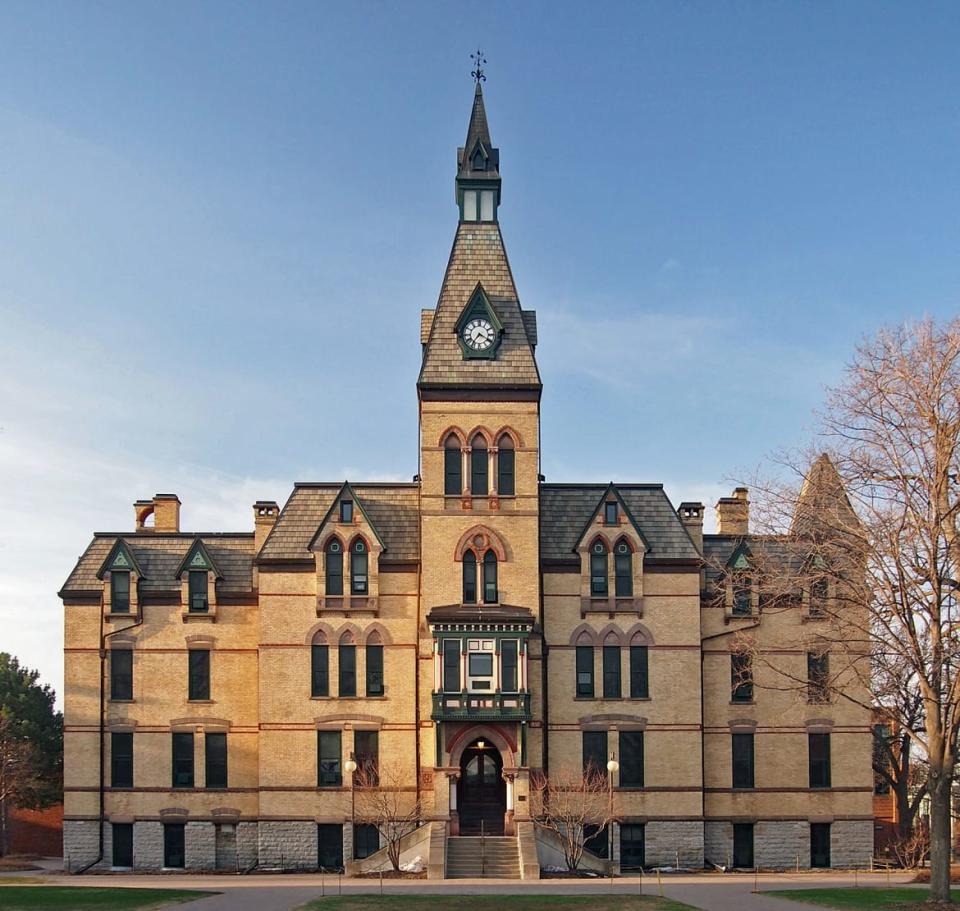A Teacher Showed Islamic Art Depicting Muhammad to College Students, and Lost Her Job

In November, an adjunct art history instructor was fired from Hamline University, a private liberal arts college in Minnesota. The month before, during an online lecture on Islamic art in the instructor’s survey of art history, she had displayed depictions of the Prophet Muhammad, which is strictly forbidden for many practicing Muslims.
While Hamline decided that the classroom exercise constituted a fireable Islamophobic offense, the images—devotional paintings of Muhammad produced by Muslim artists in the 14th and 16th centuries, respectively—were brought up in an educational context with fastidious attention taken to the sensitivity of the content.
That considered, the termination represents an administrative intrusion on the instructor’s academic freedom—ostensibly in the name of fostering the best educational environment for students—and exemplifies the precarity endemic to a higher education system ever reliant on at-will, casual labor.
Sacrificing Free Speech for ‘Civility’ at UC-Berkeley
The day after the lecture, an observant Muslim student who took issue with the images turned to Hamline’s administration to share her grievances. The professor apologized to the student via email the next day. Nonetheless, the matter escalated, and on Nov. 7, Hamline’s Associate Vice President of Inclusive Excellence (AVPIE) Dr. David Everett circulated an email to the Hamline community characterizing the lecture as “undeniably inconsiderate, disrespectful, and Islamophobic.”
In an essay published in New Lines Magazine on Dec. 22, Christiane Gruber, a historian of Islamic art at the University of Michigan who has extensively researched figural representations of the prophet, opposed the AVPIE’s description. Describing the images at the heart of the affair as common material among “Islamic art history classes at universities across the world,” Gruber argued that Hamline had wrongfully labeled the products of a rich historical “corpus of Islamic depictions of Muhammad, along with their teaching” as Islamophobic.
Hamline professor and chair of the department of religion, Dr. Mark Berkson, had defended the instructor’s academic freedom on similar grounds as Gruber in a Dec. 6 letter to the editor of The Oracle, Hamline’s student-run newspaper. But the letter was removed soon after by the paper’s staff, due to the concern that its presence on the website had purportedly “further[ed] harm to members of our community.”

Old Main, Hamline University, St Paul, Minnesota, USA.
Berkson provided a copy of the letter to The Daily Beast. Such images of the prophet, it reads, “are part of the historical record, and an academic art historian who teaches Islamic art must acknowledge and discuss this in some way” lest students “be deprived of an illuminating part of Islamic art history…”
If the very act of displaying an image of Muhammad was Islamophobic, he wrote, “anybody who showed these images in a classroom, a book, or on their wall”—including academics as well as the Muslim artists and scholars who have historically “created and enjoyed” such images—would be Islamophobic. Such a standard, requiring an “erasure of an entire genre of Islamic art” and subject of study, would have dire implications “for a liberal arts institution.”
In another school-wide email, Hamline’s president and the AVPIE wrote that they do not believe that “the indefensible” or “material that offends” should be “stricken from our classrooms and not shared with students,” before adding the caveat: “but how we teach it, and how we share images and content, matters.”
Salman Rushdie’s Stabbing Shows the Danger of Conflating Words With ‘Violence’
This neglects certain pertinent facts—such as the instructor taking numerous measures to accommodate the religious beliefs of her students.
Prior to displaying the image, the professor clarified the purpose of the exercise: “I am showing you this image for a reason,” she is quoted in The Oracle as having stated beforehand. “And that is that there is this common thinking that Islam completely forbids, outright, any figurative depictions or any depictions of holy personages. While many Islamic cultures do strongly frown on this practice, I would like to remind you there is no one, monothetic Islamic culture.”
The images were prefaced in the lecture with a two-minute introduction and content warning—and had been mentioned, as well, in the course syllabus. In her apology email to the offended student, the instructor recalled giving religious students “an ‘out’” by offering time to shut off the video component of the online lecture—after which, she claims to have “described every subsequent slide… with language to indicate when I was no longer showing an image of the Prophet Muhammad.”
Nonetheless, on Nov. 11, the AVPIE told The Oracle that Hamline’s administration “decided it was best” that the instructor “was no longer part of the Hamline community.”
Berkson informed The Daily Beast that, throughout the whole affair (from the time the AVPIE referred to the lecture as “undeniably… Islamophobic” to The Oracle interview confirming that the professor had been let go), there had been “no communication whatsoever” with the instructor.
Hamline University has not responded to The Daily Beast’s request for comment.
Here Are 5 Book Ban Trends to Watch in 2023
Free expression advocacy organizations FIRE and PEN America have issued statements referring to the dismissal, respectively, as “not acceptable at a university that commits to academic freedom” and potentially “one of the most egregious violations of academic freedom in recent memory.”
Both organizations called for the instructor’s reinstatement, and, on Dec. 24, Gruber posted a petition online urging Hamline’s Board of Trustees to conduct “an independent, outside investigation into this series of events…” Still, the damage has already been done, as such an event inevitably creates a chilling effect on the academic freedom of all instructors who cover topics that could offend students’ religious beliefs.
A Lot More Censorship Is Coming to a School Near You
It may be tempting to point fingers at Hamline students in this instance. Certainly, there have been missteps on their part (of which the student newspaper’s censorship of the only alternative perspective to that of the administration, at the time, is perhaps the most egregious example).
However, as Berkson made plain to The Daily Beast, “I don’t think that the blame should be placed on the students or the faculty member. I just think the administration should have handled this better.” For one, the incident “did not occur in a vacuum,” as the offended Muslim students have experienced real Islamophobia in their lives.
On top of that, Berkson emphasized that students with religious backgrounds who have not academically studied religion may be unaware of “all the theology, the art, the law” within their own tradition. Before it spiraled out of control, then, the controversy could have offered an opportunity to educate—if, for instance, it had led to a productive dialogue with “scholarly voices” present, facilitated by Hamline.
Instead, the administration took an unfortunate and escalatory direction. So, rather than overfocusing on the students’ conduct, perhaps scrutiny should be primarily directed toward Hamline’s administration, as well as broader trends in higher education that created the conditions for such an incident.
After all, this fiasco unfolded within an industry that has seen the evaporation of tenure-track jobs and a vast shift toward casualization—all while tuition costs balloon, in no small part to accommodate schools’ ever-growing administrative bureaucracies.
Georgetown’s Got a Serious Free-Speech Problem
The fired art teacher belonged to what has become a precarious majority in academia: adjunct instructors, employed on contingent contracts that can be terminated at the whims of their employers. Opposite this growing cohort has emerged increasingly top-down administrative apparatuses that too often consist of officials distant from the classroom, who nevertheless enjoy great (unilateral, in this case) authority over it.
The instructor’s adjunct status afforded Hamline’s administration the ability to infringe on her freedom to teach, and unilaterally deny her due process amid an unceremonious dismissal—a testament to the fact that academic freedom and academics’ job security are inextricably linked. Adjuncts’ disposability hinders their freedom to bring up controversial subjects in their classrooms.
The Hamline affair will inevitably prick the ears of all sorts of reactionaries, including true Islamophobes. Contrary to what you may hear from these alarmists, what happened at Hamline does not represent sharia law coming to American universities.
This sort of story—in which administrators, illiterate in the relevant scholarship, can smear and terminate an adjunct, and betray their institution’s professed commitment to academic freedom—is simply one to be expected out of our deeply casualized academy.
Get the Daily Beast's biggest scoops and scandals delivered right to your inbox. Sign up now.
Stay informed and gain unlimited access to the Daily Beast's unmatched reporting. Subscribe now.

